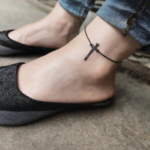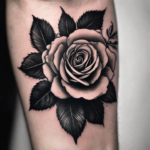Picture this: a dimly lit tattoo parlour, the buzzing of tattoo machines in the background, and a skilled artist meticulously etching intricate designs onto the canvas of someone’s skin. In this captivating world of body art, one particular genre stands out – traditional razor blade tattoos. These tattoos are more than ink on the skin; they are a testament to centuries of history, symbolism, and artistic craftsmanship. In this comprehensive exploration, we will journey through the enigmatic origins and evolution of traditional razor blade tattoos, unravel the deep-seated symbolism behind the inked images, and dive into the artistry that brings them to life. We’ll also venture into the subcultures that have embraced this unique style, address controversies and misconceptions, and hear the personal stories of those who proudly wear these tattoos. By the end of this blog post, you’ll gain a profound understanding of a tattoo style that transcends the boundaries of art and culture.
Table of Contents
Historical Roots and Evolution For Traditional Razor Blade Tattoos
Delving into the historical origins of traditional razor blade tattoos, we uncover a fascinating journey through time. These tattoos trace their lineage to ancient civilizations, where body art held cultural significance and storytelling power. From the Polynesian islands to indigenous tribes, these inked symbols were once rites of passage and markers of tribal affiliation.
Over the centuries, these tattoos evolved, shedding their original roles to become powerful expressions of personal identity and rebellion. What was once inked for battle or rituals now graces individuals from diverse backgrounds, each tattoo telling a unique story.
Throughout this evolution, cultural influences played a pivotal role. As we explore the history, we’ll highlight the significant milestones where traditional razor blade tattoos gained prominence or faced challenges. These linked narratives reflect the evolving cultures and societies that embraced them.
From ancient practices to modern interpretations, the journey of traditional razor blade tattoos is a testament to the enduring power of body art to transcend time and boundaries.

Symbolism and Iconography
Regarding traditional razor blade tattoos, the symbolism and iconography are as intricate as the designs themselves. These tattoos are rich with meaning, each element carefully chosen to convey a message or story. Exploring their symbolism reveals a world of deep-seated emotions and experiences.
We’ll explain in-depth various symbols commonly associated with traditional razor blade tattoos. For instance, the rose represents love and beauty, while the dagger can signify courage or inner strength. Understanding the meanings behind these symbols adds layers of significance to the tattoos.
To make this exploration more tangible, we’ll include examples of famous traditional razor blade tattoo designs. These iconic tattoos have left an indelible mark in the world of body art, and they serve as powerful illustrations of how symbols are incorporated into this tattoo style.
In this section, you’ll gain a deeper appreciation for the aesthetics of traditional razor blade tattoos and discover the profound stories they can tell through their symbolic language.
The Artistry and Technique
Traditional razor blade tattoos are a testament to the skill and artistry of tattoo artists who bring them to life. The intricate artistry involved in creating these tattoos is nothing short of awe-inspiring. The designs often feature bold lines, vibrant colours, and meticulous attention to detail.
We’ll delve into the techniques, styles, and aesthetics of skilled tattoo artists specializing in this genre. You’ll discover how shading and linework create depth and dimension and how colour palettes are carefully chosen to evoke specific emotions or themes. Traditional razor blade tattoos often boast a timeless, bold appearance that resembles classic tattooing styles.
In this section, we’ll also showcase the work of renowned artists who have significantly contributed to the world of traditional razor blade tattoos. These artists have mastered the technical aspects and infused their unique creativity into the genre, pushing the boundaries of what’s possible in traditional tattoo art.
Prepare to be amazed by the artistry, craftsmanship, and creative genius that goes into each traditional razor blade tattoo, a fusion of history, skill, and imagination.
Subcultures and Communities
Traditional razor blade tattoos have discovered unique spaces within various subcultures and communities, becoming more than ink on skin. In this section, we’ll embark on a journey to explore these niche communities where traditional razor blade tattoos have found a welcoming home. These tattoos hold a significant place, from the rugged brotherhood of motorcycle clubs to the fiercely independent punk rock scene. We’ll explore why these tattoos are meaningful within these groups, emphasizing their role as symbols of identity and camaraderie. Each tattoo is a badge of honour, a testament to shared values and experiences.

Controversies and Misconceptions
In the world of tattoos, traditional razor blade tattoos have been surrounded by controversies and misconceptions. Controversies often arise due to misunderstandings, linking these tattoos with violence or criminal behaviour. However, it’s crucial to debunk these myths and provide a balanced perspective. These tattoos, while edgy in appearance, are not inherently violent; they often represent personal strength, resilience, and the ability to overcome life’s challenges.
Misconceptions about the symbolism of traditional razor blade tattoos can also cloud the perception of this art form. Beyond the surface, these tattoos can convey deeply personal stories and experiences. By addressing these controversies and misconceptions openly and honestly, we aim to provide readers with a more accurate and nuanced understanding of traditional razor blade tattoos, allowing them to appreciate this unique tattoo style’s artistry and cultural significance.
The Tattooing Process: From Start to Finish
Getting a traditional razor blade tattoo is a journey that involves several crucial steps. This section will take you through the entire tattooing process, from the initial concept to the final masterpiece. It begins with a consultation, where you discuss your ideas with a skilled tattoo artist. They’ll help refine your design, ensuring it fits your vision and body.
Once the design is settled, the tattooing process begins. This involves carefully applying ink to your skin, using specialized tattoo machines and techniques. While the process may involve discomfort, skilled artists minimize pain and ensure your safety.
After the tattoo is complete, it’s time for aftercare. Proper healing and maintenance are essential to ensure your tattoo looks its best and lasts a lifetime. We’ll provide tips and guidelines for taking care of your traditional razor blade tattoo, from the initial healing stages to long-term preservation.
By the end of this section, you’ll understand what to expect when you get a traditional razor blade tattoo, making your tattoo experience smooth and rewarding.
Aftercare and Maintenance
After getting your traditional razor blade tattoo, proper aftercare and maintenance are essential to ensure it heals beautifully and stays vibrant over time. During the initial healing phase, which typically lasts a few weeks, keeping the tattoo clean and moisturized is crucial. Follow your tattoo artist’s instructions carefully to prevent infections and scarring.
Avoid exposing your fresh tattoo to direct sunlight, swimming pools, or hot tubs during healing, as this can damage the ink. As your tattoo heals, you might experience itching or flaking—resist the urge to scratch or peel the skin, as this can affect the tattoo’s appearance.
Long-term maintenance involves protecting your tattoo from excessive sun exposure by using sunscreen and moisturizing it to prevent fading. With proper care, your traditional razor blade tattoo can remain a vibrant and meaningful body art for years.
Modern Interpretations and Contemporary Trends
Traditional razor blade tattoos have evolved in exciting ways to fit the tastes and preferences of today’s tattoo enthusiasts. In this section, we’ll delve into modern interpretations and contemporary trends within the world of traditional razor blade tattoos. Tattoo artists have merged this classic style with innovative techniques, creating fresh and captivating designs.
One modern trend involves blending traditional razor blade tattoos with elements from other tattoo genres, creating hybrid styles that push artistic boundaries. From incorporating watercolour effects to experimenting with intricate geometric patterns, contemporary artists continue to redefine what’s possible with these tattoos.
Additionally, the subject matter of traditional razor blade tattoos has expanded to include a broader range of symbols and themes that resonate with modern audiences. Whether it’s to express individuality, pay homage to loved ones, or convey personal stories, these tattoos have adapted to reflect the diverse narratives of today’s society.

Personal Stories and Testimonials
Behind every traditional razor blade tattoo, there’s a personal story waiting to be shared. In this section, we’ll introduce you to individuals who have chosen to ink their skin with these captivating designs. Through their personal stories and testimonials, you’ll gain insight into the diverse motivations and experiences that drive people to embrace this tattoo style.
These stories will take you through the emotions, memories, and life events that have inspired individuals to choose traditional razor blade tattoos for self-expression. You’ll hear from those who view these tattoos as symbols of resilience, rebellion, love, or remembrance.
Through the voices of real people, we’ll bring you closer to the heart of traditional razor blade tattoos, showcasing the deep connections and personal transformations these inked narratives can spark. It’s a testament to the enduring power of body art to convey the unique stories and journeys of those who wear it.
Cultural Significance and Global Reach
Traditional razor blade tattoos hold a diverse and intriguing cultural significance that stretches globally. In this section, we’ll explore how these tattoos have become emblematic of cultural values and identities worldwide. Traditional razor blade tattoos have made their mark from the vibrant streets of East Asia to the alleys of Europe and beyond.
We’ll delve into their prevalence and variations in various countries and cultures, shedding light on the emerging unique interpretations and adaptations. By examining their global reach, we’ll reveal the universal themes that resonate with individuals worldwide and how these tattoos serve as bridges between cultures.
Through this exploration, you’ll gain a deeper appreciation for the cross-cultural appeal and the interconnectedness of traditional razor blade tattoos, demonstrating how they transcend borders to become symbols of personal and cultural significance.
Conclusion
In conclusion, our journey through the world of traditional razor blade tattoos has been a fascinating exploration of history, artistry, and culture. We’ve uncovered the deep-seated symbolism and iconography behind these tattoos, delved into their rich history and evolution, and examined their significance within diverse communities.
Traditional razor blade tattoos are more than just ink on the skin; they are a canvas that tells stories, symbolizes strength, and fosters belonging. As we’ve seen, these tattoos have not been without controversies and misconceptions, but they continue to thrive as a unique and enduring art form.
Ultimately, we encourage you to appreciate and respect the cultural richness of traditional razor blade tattoos. They are a testament to the human desire for self-expression, identity, and the enduring power of art. These tattoos have transcended time and borders to become a vibrant part of our diverse cultural tapestry, a living reminder that body art is a profound form of storytelling.










